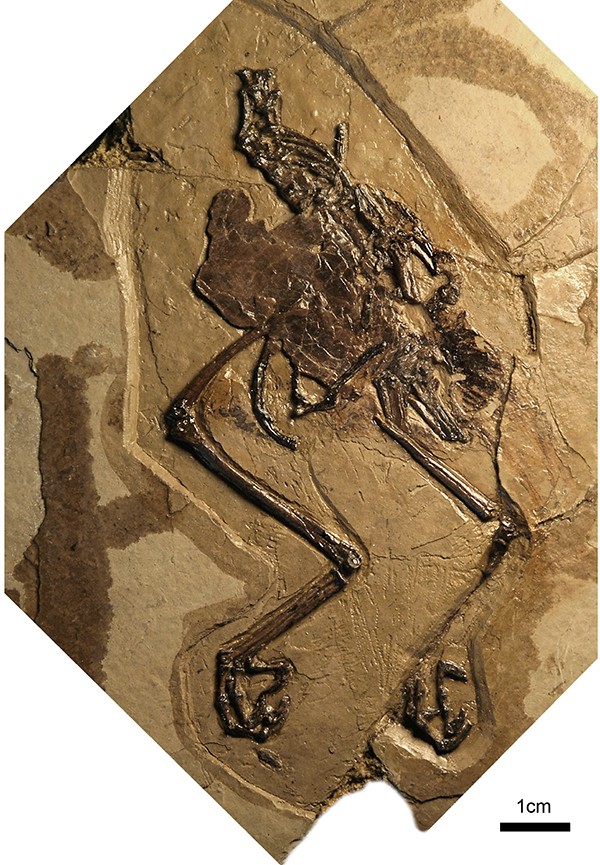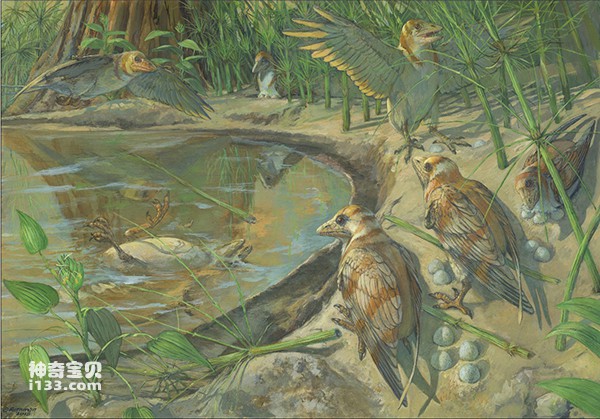The evolutionary success of birds is inseparable from their unique reproductive and incubation systems. On March 21, the team of Zhou Zhonghe, Zou Jingmei, and Bayolle reported online in the British magazine Nature Communications the world's first extinct bird with eggshells in its abdominal cavity - the fossil of enantiornithes. It provides new information for studying the reproduction of ancient birds, and further provides new evidence for exploring the evolutionary process of early birds.
This specimen was discovered in the lake sediments of the Xiagou Formation of the Early Cretaceous 110 million years ago in Yumen City, Gansu Province, China. It is a completely new genus and species, named Avimaia schweitzerae. The specimen is preserved in flat shale. Although the head is incomplete, the basically formed eggshell (including surface membrane, cuticle, etc.) in the body cavity has been rarely preserved to this day.
Tissue sections and scanning electron microscopy results showed that the eggshell was unusually thin, showing a double-layered pathological structure (this is also the first time that double shells have been found in an enantiornithian egg fossil). Based on this, the researchers speculated that the female bird appeared when laying eggs. It has solved the "egg entrapment syndrome" common in living reptiles, that is, the eggs are not produced in time and stay in the body cavity for a long time. Some living birds will have this symptom when they are under great pressure to survive or due to nutritional deficiencies. In some living turtles and even some sauropod dinosaur fossils, this symptom appears. The situation is also relatively common.
The study also found that the outermost layer of the eggshell membrane is composed of small spherical mineral particles. Egg membranes composed of dense spherical mineral particles are often found in living birds that build their nests near humid environments. (such as quails, ducks, flamingos, etc.), this structure can isolate moist air, thereby avoiding corresponding infection problems, which is consistent with the habit of anti-birds to build nests in situ and partially bury eggs, while the protective layer of spherical mineral particles The existence of may represent a more primitive bird egg form.
In addition, suspected medullary bone was also found in the leg bone fragments of this specimen. Medullary bone is a source of calcium for eggs when female birds lay eggs, and is mostly formed in the cavities of long bones. However, most of the "medullary bones" reported by previous people are open to question, and many are actually caused by pathology or other reasons. This specimen rarely has two conclusive evidences of gender identification, egg and medullary bone, which is conducive to Researchers identified the sex of ancient birds and further explored the sexual dimorphism characteristics of primitive birds.
This research was funded by the National Natural Science Foundation of China Basic Science Center Project "Cratonic Destruction and Terrestrial Biological Evolution", the Chinese Academy of Sciences International Talent Initiative (PIFI) project, and the Chinese Academy of Sciences Pilot Project.
Original link: https://www.nature.com/articles/s41467-019-09259-x

Figure 1 Photo of the holotype specimen of Stonebirds (photo courtesy of Alida Bailleul)

Figure 2 Restoration picture of Shi’s Lovebird (Photo courtesy of Alida Bailleul)
animal tags:
We created this article in conjunction with AI technology, then made sure it was fact-checked and edited by a Animals Top editor.